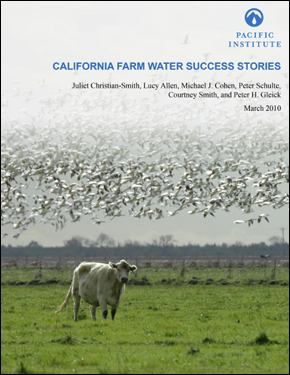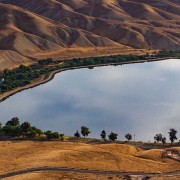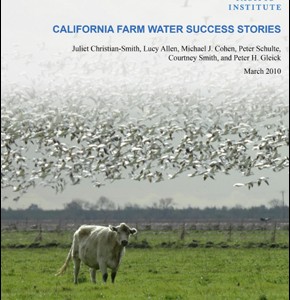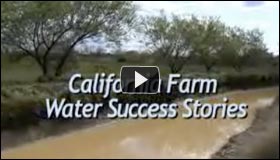Peter Gleick: Farm Water Success Stories
The Pacific Institute has just released a new report, California Farm Water Success Stories, including a separate video, describing a variety of different examples of innovation in California’s agricultural sector showing the way toward more efficient water management and use. This report is a follow-on to our major 2009 study of the potential for improving water-use efficiency in California agriculture.
Water Numbers: 5, 7, and 8: The report describes in detail seven different case studies and the eight-minute video features five California growers and water managers. The full report and the video (along with supplemental interviews, videos, an Executive Summary, and press release) can be downloaded from the Pacific Institute website at http://www.pacinst.org/reports/success_stories/index.htm. The five California growers and water managers in the video include: Karen Ross, the past president of the California Association of Winegrape Growers; Craig McNamara of Sierra Orchards; Dale Huss of Sea Mist Farms; almond grower Tom Rogers; and Panoche District Water Master Marcos Hedrick.
Some flavor for these success stories? In Madera County, almond grower Tom Rogers has reduced water use by up to 20% in some fields with careful monitoring and irrigation scheduling. Dale Huss of Sea Mist Farms describes how they’ve become the world’s largest user of high-quality recycled water. Craig McNamara shows how innovative financing mechanisms, drip technology, and careful management has boosted yields while reducing water needs, as well as his efforts in public education and ecosystem restoration. Karen Ross describes the Sustainable Winegrowing Program that created a program to provide the wine and grape-growing industry with data to communicate their progress to customers and regulators and a mechanism through which their farmers can identify opportunities to increase efficiencies, manage risks, improve product quality, and cut costs. Growers are working with the Department of Fish and Game to manage some of California’s last remaining seasonal wetlands — the Yolo Bypass Wildlife Area, a critical habitat for migrating birds — while still maintaining crop production. The value of good information is demonstrated by the Coachella Valley Water District’s agricultural water-efficiency initiative, known as the Extraordinary Water Conservation Program, which documented savings totaling more than 75,500 acre-feet of water over six years.
And the report has much more.
This new Pacific Institute report highlights seven examples of innovations in agriculture that save water and provide multiple other benefits.

With sustainable water policies and practices, innovative growers like these are moving California toward more equitable and efficient water management and use. “Mounting evidence of the effectiveness of farm water conservation and efficiency strategies is good news for policymakers and water managers,” said Dr. Juliet Christian-Smith, senior research associate at the Pacific Institute and lead author of the report. “Our study demonstrates that long-term sustainable use of water doesn’t require drastic advances in technology or heroic or extraordinary actions. It requires a commitment to sustainability and efficiency and the will to expand positive trends that are already underway.”
The cases in the Pacific Institute report and accompanying video demonstrate diverse strategies that can reduce pressures on scare water resources, effective planning and management practices, the role for technological improvements, the potential for using alternative sources of water, and the value of setting quantitative targets and providing financial incentives. The results are efficient water use or enhanced water quality, increased crop yields or quality, and multiple benefits for other water users, such as providing increased flood protection, drought-resilience, or habitat for wildlife.
The report offers several cross-cutting conclusions, including:
Managing for multiple benefits. Each of the case studies offers multiple benefits and collaborations among diverse sectors of the economy.
Accurately measuring and monitoring water use. The most significant improvements in efficiency require good information on water use, climate and weather conditions, and more.
Capturing the untapped potential of existing technologies. In recent years, California farmers have made progress switching to water-efficient systems for distributing and using water but much more potential remains untapped. No new magic technology needs to be developed.
Setting targets and providing economic incentives to accelerate progress. Several of the case studies show how quantitative targets and economic incentives can be effective tools to accelerate water management improvements.
These success stories are just a few examples of the innovations already occurring throughout California agriculture, with committed individuals and groups finding better ways to manage our state’s scarce freshwater resources. It is important to incorporate the lessons drawn from these case studies in future water policy and planning in order to accelerate the adoption of sustainable water management principles and practices.
Peter Gleick
Dr. Gleick’s blog posts are provided in cooperation with the SFGate. Previous posts can be found here.









